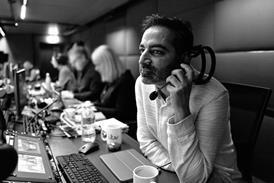Miniaturisation in electronics has had a profound effect on all areas of life since Gordon Moore first observed in 1965 that the number of transistors you could place on an integrated circuit for a minimum cost doubles every two years. Moore's resulting law has seen computers shrink from the size of rooms to almost invisible ubiquity, revolutionising technology and reshaping society along the way.
But the trend towards miniaturisation invariably comes to a halt when it starts to have an impact on form and function, and broadcast cameras and camcorders are no exception. Cameras - with the exception of specialist miniature units (see box) - have to be ergonomically designed and useable with a minimum of extra training.
And while handheld units have introduced a new way of shooting, the design of cameras is mainly constrained by two factors: the lens and the human body. As Klaus Weber, director of product marketing cameras Thomson Grass Valley, says: “This is optics, this is physics. There are laws here that you can't change.”
For shoulder-mount cameras, which have standardised worldwide on 2/3-inch chips, a lens typically weighs about 1.5kg. This is supported by a bent arm, meaning the unit has to be counterweighted so that the arm does not get too tired, too quickly. Camera designers achieve this by putting more weight behind the shoulder. Weber says the ideal overall weight is probably 4-5kg, with a certain degree of heft necessary to provide stabilisation, ideally with an accompanying low centre of gravity.
“There is a point at which a camera becomes too light and balance is as important as weight,” says Ikegami UK general manager Mark Capstick. “I've seen people putting lead weights on the back of our studio cameras when they wanted to balance a big wide-angle lens on the front.”
Close to the edge
In other words, it's not just about making things smaller. “If you took the side covers off our system cameras, you would see quite a lot of space between the boards,” says Weber. “We could go smaller there if we wanted to.”
Camcorders are a slightly different matter. While their “form factor” (shape) has remained largely static, miniaturisation has effectively enabled manufacturers to add more features without weight penalties, with multi-format capability - up-, down- and cross-conversion - and wireless mic slots now commonplace. Not much more can be squeezed in at present. “I would say that for a fully featured camcorder, now we're quite close to the edge,” says Weber.
The same pattern of reduced cost, weight and added features has been repeated in the handheld market. “Three or four years ago these would have been £15,000 cameras and twice the weight they are today,” says Sony's XDCAM product manager Phil Myers. “Now they have many of the ‘big' camera features.”
Compromises
“Ruggedisation” is generally as good as the larger format cameras, with Pro Motion Hire managing director Duncan Martin pointing out that camera bodies in general tend to be robust now, and that it is the additional components, leads and connectors that can get snagged and broken.
The pros of handheld cameras are undoubtedly manoeuvrability and cost. At Broadcast Video Expo, Discovery's John Honeycutt revealed that the channel chose HDV handhelds for shooting Deadliest Catch because smaller cameras were better for crew safety and they destroy 40+ of them per series. But they tend to perform less well in low light and have a large depth of focus.
“[Handheld cameras] put way too many compromises into the operation,” comments Guild of Television Cameramen chairman Brian Rose. “You can't hold them steady, you can't focus their built-in lenses properly and, with HD in particular, you can't afford to compromise on quality.”
The big question is: are handhelds fit for purpose? In February, ITV News bought 68 Sony HVR-Z5Es for its multi-skilling journalists, with Sony product manager Rob France reasoning that prosumer-oriented features such as auto-focus can be an important selling point at that end of the market. Handhelds also illustrate the compromises that camera designers have to make. “The EX-1 and EX-3, for example, have a big sensor and lens on the front, so we made them record on to memory-based media as there wasn't room or weight for tape,” says France. “And because the Z5E uses tape, in that camera we found ourselves reducing the sensor size.”
The compromises needed to keep cameras small and lightweight can be problematic, especially when it comes to the demands of broadcasters. VMI managing director Barry Bassett reels off a range of cameras where either the chip size (sub-1920 x 1080) or the recording format (sub-50Mbps) is unacceptable to some broadcasters.
“They demand that operators shoot with an EX-3, for example, and record on a (large) external flash ram recorder at 50Mbps data speed, which takes all of the advantage of the size of the cameras away,” he says. “Small is great but the specs often don't comply with increasingly demanding broadcasters.”
Which is why, for handhelds as well as shoulder-mounts, the benefits of miniaturisation from now on are likely to be an increase in functions rather than a reduction in form factor.
“The main thing for professional cameramen is that they like key camera features - such as gain, shutter and white balance - to be accessible via physical buttons and switches on the camera, rather than by the software menu,” says John Kelly from JVC, which has just pushed miniaturisation to a new level with the 1.4kg JVC GY-HM100E compact handheld camcorder.
New developments are on the way. Whether this will shrink cameras yet further is debatable. “The minimum size for professional use won't get much smaller than the Panasonic HPX range or Sony's EX,” says Panasonic's UK marketing manager Marc Irwin. “A pro doesn't want something that sits in the palm of their hand - it can't provide all the functionality they need.”
POV Cameras: Small is beautiful
The real champions of broadcast camera miniaturisation are the point of view (POV) cameras, commonly referred to as lipstick cams, or the cameras you get when you decouple the camera head from the control unit.
Sony's new HXR-MC1P is a good example: a full HD unit with a 10x optical zoom that measures a mere 37 x 42.5 x 86.5mm and weighs 580g - a figure that also includes the control unit. Product manager Rob France reports: “The numbers shipped out to dealers have been strong, and people are typically talking about taking them in quantities of tens or twenties.”
According to Robin Parker, co-founder of specialist hire firm Action Cameras, the POV market is around 90% enthusiast, with production companies making up only 10%. The £550 VIO POV 1.5 (pictured right) is currently the most popular model of the five broadcast-quality models it carries, being waterproof, dustproof and shock-resistant. The drawback is that it's limited to a 720 x 480 resolution.
Despite the drawbacks, POV cameras are increasingly becoming capable beasts. Iconix debuted a 2K model at last year's NAB, and the small 64g size of the camera has made sure it has garnered lots of interest for mounting on stereoscopic 3D rigs.
Silicon Imaging's SI 2K boasts a detachable camerahead that can operate up to 100m from the camera body and was used to great effect in Slumdog Millionaire's slum scenes.
“The size of the POV cameras is staying the same, but the quality we are getting out of them is improving all the time,” comments Axis Films head of cameras Paul Carter.
Miniature Broadcast Cameras launched the RubiCam last year. HD/SD switchable, the zoom focus and iris can be controlled from a remote panel. “With other cameras the shot has to be set up, and if the light level changes you've lost it,” says managing director Neil Davies.
JVC's GY-HM100E in numbers
Weight (kg) 1.44
Volume (cc) 8966
Dimensions (mm) 138 x 178 x 365
Power consumption (W) 7.2
Recording time (hours) 6
HD recording modes (50Hz, HQ) 5


























No comments yet